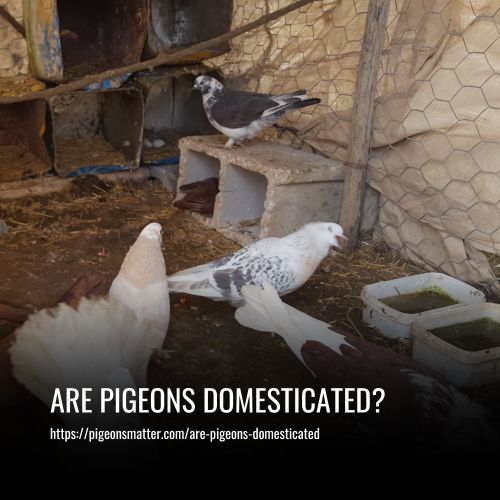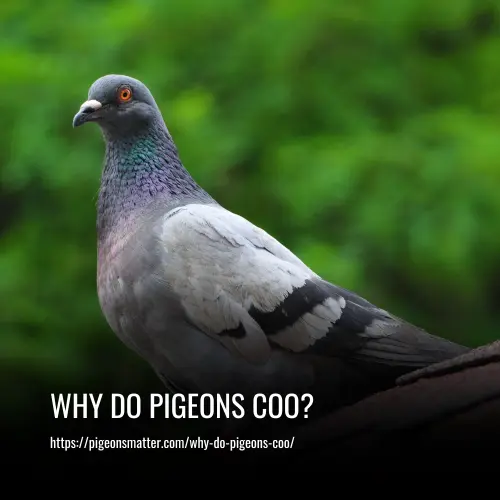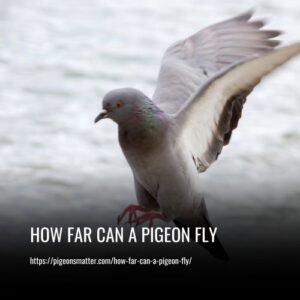Pigeons are semi-domesticated animals. While they have been bred and raised by humans for specific purposes, such as racing or as pets, they still maintain many of their natural instincts and behaviors. Pigeons have the ability to survive and adapt in urban environments without direct human intervention, which is a characteristic of wild animals.

What Are Domestic Pigeons
Domestic pigeons are a type of bird that belongs to the Columbidae family. While there are many species of pigeons and doves, domestic pigeons usually refer to breeds of the rock pigeon, Columba livia. These birds have been kept as pigeons for thousands of years and are popular worldwide, with over 350 recognized breeds. They are often associated with humans in literature, art, and religion and have even been used as messengers during war and peacetime.
Like other domesticated animals such as dogs and chickens, domestic pigeons have been selectively bred for particular traits over time. This has resulted in a wide variety of pigeons within the species, with some breeds being selected for flight characteristics while others are bred for vocal traits and unique physical characteristics. Pigeon breeding is a popular hobby and has resulted in arguably the greatest phenotypic diversity within any single avian species.
Diversity Among Breeds of Domestic Pigeons
Domestic pigeons come in a wide range of breeds, each with its own unique characteristics. In fact, the variation among pigeon breeds can be as significant as that observed among different species of birds. For example, some breeds exhibit extreme differences in beak size, such as the African owl and Scandaroon.
Other breeds have distinct features like the head crest of the Old German owl and the hood of the Jacobin. The fantail breed boasts supernumerary and elevated tail feathers, while the Brunner pouter and English pouter have scales and feathers on their lower legs and feet respectively. These variations are fascinating and showcase the incredible diversity that can be found within the world of domestic pigeons.
The History of Pigeon Domestication
Pigeon domestication is a practice that dates back thousands of years and has been documented by historians. The earliest known domesticated pigeon was found in Sumerian texts from 3000 BC. Since then, pigeons have been bred for various purposes, including their meat, feathers, and ability to carry messages over long distances.
The domestication of pigeons has spread across many cultures worldwide. In India, they were used as service birds for Emperor Akbar in the 16th century. In Europe, the practice became popular during the Renaissance period, when certain varieties of pigeons were believed to have magical powers. Pigeon racing became a popular sport in Victorian England.
Today, pigeon breeding remains a popular hobby for enthusiasts who are interested in the variety of breeds and colors that can be produced through selective breeding. Some people keep them as pet pigeon, while others use them for competitive racing or other sporting activities.
Domestication
Pigeons have been intertwined with human history for thousands of years, serving various purposes such as food, pets, and even as post carriers. The earliest known mention of pigeons dates back 5,000 years ago in Mesopotamia, while the ancient Egyptians kept large quantities of them and used them for ritualistic sacrifices. Akbar the Great even traveled with thousands of pigeons as part of his entourage. Pigeons were introduced to the Americas around 400 years ago, and by the 18th century, interest in fancy pigeons grew, leading to the expansion of pigeon breeds.
Limited information is available regarding the domestication of pigeons, despite their extensive historical presence. The first subspecies of C. livia to be domesticated, when, how many times, where, and how they spread is uncertain. The fragility of their bones and resemblance to wild birds make it difficult to use the fossil record as a dependable means of studying their domestication. Written accounts provide the most information, but likely do not cover the earliest stages. The extensive interbreeding between domestic and feral pigeons and wild pigeons further complicates the origins of pigeons.
From a genetic perspective, there are two ancestral clades of pigeons. However, genetic homogeneity has occurred due to frequent interbreeding and human-directed cross-breeding. The first clade is characterized by exaggerated features such as crops, tails, and manes. The second clade includes tumblers, homing pigeons, owl pigeons, and those with exaggerated wattles.
When And Where Were They Domesticated
The domestication of pigeons is a complex topic due to widespread hybridization and introgression among breeds. Genetic measures indicate that domestic breeds are only weakly differentiated, possibly due to crossbreeding to enhance certain traits. As a result, the precise number and timing of domestication events remain unclear.
Rock pigeons are native to Europe, North Africa, the Middle East, and South Asia, and were probably domesticated at various times and places. Evidence of human use of pigeons as a source of food dates back to the Pleistocene era in the Fertile Crescent, although it is uncertain if this involved domestication. Ancient Egyptians began using pigeons for ceremonial and culinary purposes at least 4000 years ago, and later as indicators of the Nile’s annual flood. Some modern breeds, such as resplendent fantails and runts, were likely developed over 860 and 2000 years ago, respectively.
The origins of many other fancy breeds are unknown, but the Middle East and South Asia (modern India and Pakistan) appear to be the ancient geographic centers of domestic pigeon diversity. Bird exchanges between these regions in the 16th century and earlier provided ample opportunities for crossbreeding among breeds. Written records from the 16th century and earlier describe derived morphological and behavioral traits and breeds that still exist today. Pigeon hobby popularity rose in Europe during the 17th century, and artistic depictions of some domestic breeds from this era resemble modern forms.
What Are Homing Pigeons And How Do They Navigate
Homing pigeons have amazed humans for centuries with their innate ability to navigate back to their home loft over unfamiliar terrain. They have been used as message bearers for millennia, with Julius Caesar even utilizing them to communicate his victory over Gaul to Rome.
The modern racing homer breed was created in the early 1800s through the hybridization of several different breeds, followed by the interbreeding of these two racing strains. Today, pigeon racing is a popular sport with prize purses reaching thousands of dollars. Generations of intense selection have enhanced the homing ability to race strains, with the hippocampus, an important part of the vertebrate brain for spatial learning and memory, being larger in racing homers than in wild rock pigeons.
Experiments suggest that pigeons rely on the position of the sun, the direction and intensity of the geomagnetic field, and olfactory cues when far away from home. As they near their home loft, they switch to visual landmark navigation. Magnetoreception cells, recently discovered to reside in the inner ear lagena, signal to neurons in the vestibular brainstem and respond to the direction, polarity, and intensity of a magnetic field, which vary based on geographic location.
While the relative importance of each homing cue to navigation is not entirely clear, pigeons likely use information opportunistically depending on environmental conditions.
What Are Feral Pigeons
Feral pigeons are free-living descendants of escaped domestic pigeons. They are found on all continents except Antarctica and have been present in some areas for thousands of years.
In North America, they have been feral birds for over 400 years and have undergone natural selection resulting in their close resemblance to wild rock pigeons in the Old World. Some North American feral populations have been found to have genetic contributions from the racing homer breed, which has opportunities to fly outside and potentially escape.
The Role of Humans in Pigeon Domestication
The domestication of pigeons has been largely influenced by humans. Through selective breeding, humans have been able to create diverse breeds of pigeons with unique appearances and behaviors. In regions such as the Middle East and South Asia, humans have been selectively breeding pigeons for hundreds or even thousands of years, resulting in the development of many fancy breeds that still exist today.
More recently, humans have selectively bred pigeons to excel in navigation, often using them in racing competitions. By selectively breeding pigeons with the best navigation skills, humans have created a breed that is highly skilled at finding its way home from long distances. Overall, the role of humans in pigeon domestication has been significant in shaping the diverse range of pigeon breeds we see today.
Why Did Darwin Value Domestic Pigeons
Charles Darwin had a special appreciation for the rock pigeon, a species that is often overlooked by ornithologists. In fact, he used the diversity within this species to illustrate his ideas about natural selection in The Origin of Species. Darwin recognized that artificial selection, which is used to breed domesticated animals like pigeons, was similar to natural selection.
He took a keen interest in the extreme variation among domestic pigeons that evolved from a common wild type. Darwin believed that studying a specific group in detail was the best way to understand evolution, and he chose domestic pigeons as an exemplar of diversity under domestication. He noted that the materials available for studying domestic pigeons were better than for any other group of domesticated animals.
Darwin observed that some domestic pigeon breeds were as distinct as different genera of wild pigeons and doves based on external morphology alone. However, he also noted that even highly divergent domestic breeds could be crossed to produce viable offspring, and thus they belonged to the same species.
What Do We Know About The Genetic Basis Of Variation Among Pigeons
Pigeons are a promising model for studying avian and vertebrate evolutionary genetics due to their varying traits among breeds and natural species of birds. The genetic architecture for many traits is relatively simple, making it easier to identify genes responsible for differences among breeds. Additionally, variation in several traits shows similar trends in distantly related breeds, allowing for testing whether the same or different genes underlie similar phenotypes in different breeds.
Recently, a reference genome sequence of the rock pigeon was assembled, allowing for the exploration of the molecular origins of diversity within and among breeds. By sequencing the genomes of breeds with and without crests of reversed feathers on their heads, a coding mutation in the Ephrin receptor B2 (EphB2) gene was found to be shared among breeds with crests. The head crest mutation likely evolved just once and spread to a variety of breeds through either hybridization, repeated selection on a mutation already present in a wild rock pigeon population, or both.
Further studies using genomic resources can now rigorously test whether the same genetic basis underlies similar derived traits in different pigeon breeds for additional traits. The domestic birds tremendous amount of phenotypic diversity, coupled with tractability in genetics, genomics, and developmental biology, makes it a powerful model for understanding trait evolution and development in vertebrates.
FAQs
Some domesticated pigeons may struggle to survive in the wild due to their reliance on humans for food and shelter. However, wild pigeon populations have been established in many urban areas.
Domesticated pigeons are used for various purposes, including racing, homing, and as message carriers. They have also been used as a food source in some cultures.
Yes, pigeons are considered to be highly intelligent animals. They have excellent homing instincts and are able to navigate long distances to find their way back to their home lofts.
Yes, pigeons are highly trainable animals and have been used for centuries as messengers, performers in circuses and magic shows, and in racing competitions.
Pigeons can be trained using a combination of positive reinforcement, repetition, and consistency. Training methods may vary depending on the desired task, such as racing or message delivery.
Pigeons are relatively low maintenance pets. They require a clean living environment, a balanced diet, and regular access to fresh water.
Pigeons are often considered pests in urban areas due to their ability to create messes with their droppings, cause damage to buildings, and compete with native bird species for resources.
Conclusion
While pigeons have been living alongside humans for thousands of years, they are not considered fully domesticated. They still retain their natural instincts and behaviors and are able to survive in the wild without human intervention.
However, their close relationship with humans has led to many unique and interesting adaptations, such as the ability of pigeons to navigate and communicate with us. Whether you consider them wild or domesticated, there is no denying that pigeons are fascinating creatures with a rich history and many unique characteristics.


